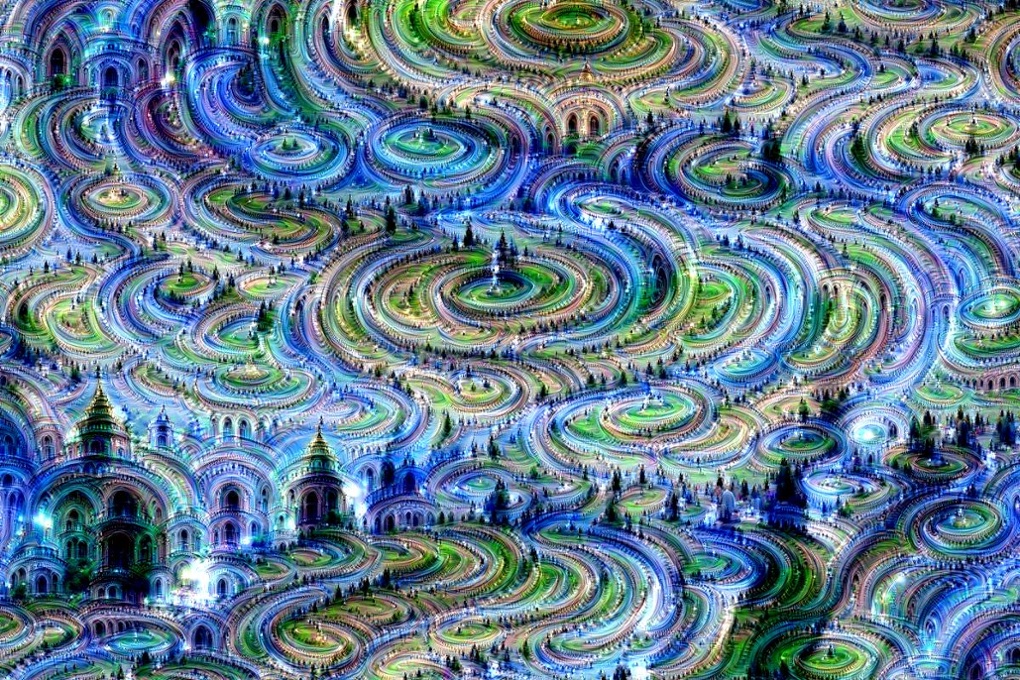【Halinghing】
2025-06-26 00:10:27
991 views
976 comments
Far-Out Kandy-Kolored Machine Dreams,Halinghing and Other News
On the Shelf

A “dreamscape” made from random noise. Illustration: Google, via the Guardian
- As an undergraduate at Harvard, T. S. Eliot risked flunking out—but fear not, for his febrile poetic mind was already hard at work: “He invented the characters of ‘Columbo’ and ‘Bolo,’ who for years to come starred in a series of scatological, violent, and racist poems. Circulated privately, these verses became known to a wider readership only after Eliot’s death, when they presented the immensely refined poet in a bizarrely crude light … such writing served a purpose for the shy, physically awkward, and sexually late-blooming Eliot. It was a way for him to bond with his peers … ”
- Advertisements used to contain words—many words—even those aimed at such famously illiterate audiences as rock-music fans. A look at the Rolling Stonearchive reveals a surprising amount of po-mo sophistication in record-label copywriting. A 1979 ad for the singer-songwriter Sirani Avedia, for example, begins, “After the chic anarchy of punk, the escapism of disco, and the cerebral celebrations of jazz fusion … something real.”
- An old photograph by Giovanni Gargiolli inspires ruminations on fatherhood: “The photograph was taken outside a Franciscan church in Alatri, a village south of Rome, in 1902 or 1903 … I recognize myself in that father who is leaning out of the family portrait in the church doorway. I feel an apartness, and I wonder: Is it a movable obstacle to the fullness of fatherhood, a primordial paternal taint, or a simple truth about the way men who have children are around their children?”
- Disturbing news from the tech sector: research suggests that our computers, the very beings on which our civilization depends, are no more than drug-addled dreamers, lost in psychedelic reveries every bit as inscrutable as those of your average dusthead. Google discovered what its image-recognition networks “imagine” by “feeding a picture into the network, asking it to recognize a feature of it, and modify the picture to emphasize the feature it recognizes. That modified picture is then fed back into the network, which is again tasked to recognise features and emphasize them, and so on. Eventually, the feedback loop modifies the picture beyond all recognition.”
- Nick Sousanis received his doctorate in education for Unflattening, a dissertation in the form of “a graphic novel about the relationship between words and pictures in literature.” Its lowly ambition? “Insurrection against the fixed viewpoint … Fusing words and images to produce new forms of knowledge.”
Search
Categories
Latest Posts
Hockey Sausage
2025-06-25 23:49Google Photos is making sharing pictures with friends even easier
2025-06-25 23:28Watch out Google Earth, Apple Maps has a hidden VR
2025-06-25 23:27For about 10 minutes, people thought Amazon was going to buy FedEx
2025-06-25 21:26Old-School Organizing in the Heartland
2025-06-25 21:25Popular Posts
Who’s Afraid of Ocasio-Cortez?
2025-06-26 00:03Ditto doll is looking damn good in its new purple wig
2025-06-25 22:46A Serious Man
2025-06-25 22:41Featured Posts
Who’s Afraid of the Russian Soul?
2025-06-25 23:33Ancient 'skull cult' might've carved up bones to shame their enemies
2025-06-25 22:58The Budget and the Political Imagination Deficit
2025-06-25 21:53Popular Articles
Between Oligarchy and Democracy
2025-06-25 23:11iPhones of the future may memorize your sleep patterns
2025-06-25 22:51Samsung Bixby is promising, but Siri has nothing to worry about
2025-06-25 22:43A Show Trial that No One Watched
2025-06-25 22:00Newsletter
Subscribe to our newsletter for the latest updates.
Comments (2474)
Image Information Network
Faster, Higher, Stronger, More Harmonious
2025-06-25 22:25Fashion Information Network
This Instagram account teaches you the LGBTQ history you never learned in school
2025-06-25 22:24Wisdom Information Network
Apple, Waymo partner with car rental companies for driverless cars
2025-06-25 22:16Progress Information Network
Here's a way Facebook is actually fighting fake news
2025-06-25 21:46Inspiration Information Network
The Permanent Vactioner
2025-06-25 21:44